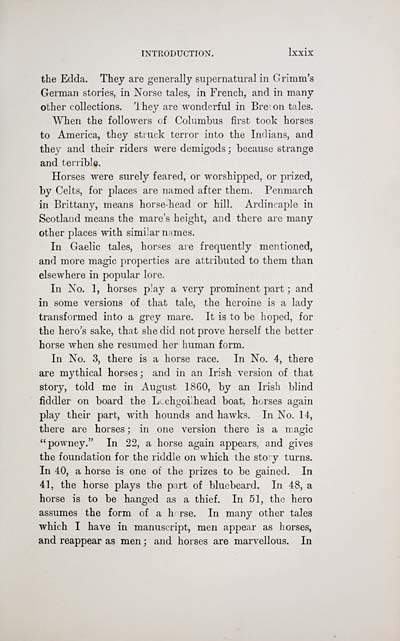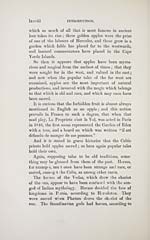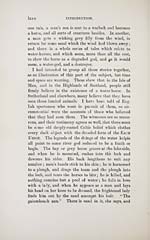Download files
Complete book:
Individual page:
Thumbnail gallery: Grid view | List view

INTRODUCTION. IxxÌX
the Edda. They are generally supernatural in Grimm's
German stories, in Norse tales, in French, and in many
other collections. Ihey are wonderful in Brs'-on tales.
When the followers of Columbus first took horses
to America, they struck terror into the Indians, and
they and their riders were demigods ; because strange
and terrible.
Horses were surely feared, or worshipped, or prized,
by Celts, for places are named after them. Penmarch
in Brittany, means horse-head or hill. Ardincaple in
Scotland means the mare's height, and there are many
other places with similar names.
In Gaelic tales, horses are frequently mentioned,
and more magic properties are attributed to them than
elsewhere in popular lore.
In No. 1, horses play a very prominent part ; and
in some versions of that tale, the heroine is a lady
transformed into a grey mare. It is to be hoped, for
the hero's sake, that she did not prove herself the better
horse when she resumed her human form.
In No. 3, there is a horse race. In No. 4, there
are mythical horses ; and in an Irish version of that
story, told me in August 1860, by an Irish blind
fiddler on board the L.chgoilhead boat, horses again
play their part, with hounds and hawks. In No. 14,
there are horses ; in one version there is a magic
"powney." In 22, a horse again appears, and gives
the foundation for the riddle on which the stoy turns.
In 40, a horse is one of the prizes to be gained. In
41, the horse plays the part of bluebeard. In 48, a
horse is to be hanged as a thief. In 51, the hero
assumes the form of a h rse. In many other tales
which I have in manuscript, men appear as horses,
and reappear as men ; and horses are marvellous. In
the Edda. They are generally supernatural in Grimm's
German stories, in Norse tales, in French, and in many
other collections. Ihey are wonderful in Brs'-on tales.
When the followers of Columbus first took horses
to America, they struck terror into the Indians, and
they and their riders were demigods ; because strange
and terrible.
Horses were surely feared, or worshipped, or prized,
by Celts, for places are named after them. Penmarch
in Brittany, means horse-head or hill. Ardincaple in
Scotland means the mare's height, and there are many
other places with similar names.
In Gaelic tales, horses are frequently mentioned,
and more magic properties are attributed to them than
elsewhere in popular lore.
In No. 1, horses play a very prominent part ; and
in some versions of that tale, the heroine is a lady
transformed into a grey mare. It is to be hoped, for
the hero's sake, that she did not prove herself the better
horse when she resumed her human form.
In No. 3, there is a horse race. In No. 4, there
are mythical horses ; and in an Irish version of that
story, told me in August 1860, by an Irish blind
fiddler on board the L.chgoilhead boat, horses again
play their part, with hounds and hawks. In No. 14,
there are horses ; in one version there is a magic
"powney." In 22, a horse again appears, and gives
the foundation for the riddle on which the stoy turns.
In 40, a horse is one of the prizes to be gained. In
41, the horse plays the part of bluebeard. In 48, a
horse is to be hanged as a thief. In 51, the hero
assumes the form of a h rse. In many other tales
which I have in manuscript, men appear as horses,
and reappear as men ; and horses are marvellous. In
Set display mode to: Large image | Transcription
Images and transcriptions on this page, including medium image downloads, may be used under the Creative Commons Attribution 4.0 International Licence unless otherwise stated. ![]()
| Early Gaelic Book Collections > Matheson Collection > Popular tales of the west Highlands > Volume 1 > (99) |
|---|
| Permanent URL | https://digital.nls.uk/81388416 |
|---|
| Description | Volume I. |
|---|---|
| Shelfmark | Mat.74 |
| Additional NLS resources: | |
| Attribution and copyright: |
|
| Description | Items from a collection of 170 volumes relating to Gaelic matters. Mainly philological works in the Celtic and some non-Celtic languages. Some books extensively annotated by Angus Matheson, the first Professor of Celtic at Glasgow University. |
|---|
| Description | Selected items from five 'Special and Named Printed Collections'. Includes books in Gaelic and other Celtic languages, works about the Gaels, their languages, literature, culture and history. |
|---|

